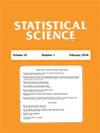使用校准良好的零偏好先验解释p值和置信区间
IF 3.9
1区 数学
Q1 STATISTICS & PROBABILITY
引用次数: 2
摘要
我们提出了校准良好的零偏好先验,用于单侧假设检验,从而得出贝叶斯和频率论推断一致。零偏好先验意味着他们对零假设有近100%的先验信念,而校准良好的先验意味着对替代假设的后验信念不会过于自信。该公式扩展了给出贝叶斯频率论一致性的一类问题,包括涉及离散分布的问题,如二项式和负二项式一样本和两样本精确(即有效)检验。在适用的情况下,这些先验给出了零假设的后验信念,即有效的p值,而零偏好先验强调大的p值可能只是代表不足以推翻先验信念的数据。该公式对一些常见的频繁度测试进行了贝叶斯解释,并更直观地解释了两个样本测试的鲜为人知和不太直接的置信区间。本文章由计算机程序翻译,如有差异,请以英文原文为准。
Interpreting p-Values and Confidence Intervals Using Well-Calibrated Null Preference Priors
We propose well-calibrated null preference priors for use with one-sided hypothesis tests, such that resulting Bayesian and frequentist inferences agree. Null preference priors mean that they have nearly 100% of their prior belief in the null hypothesis, and well-calibrated priors mean that the resulting posterior beliefs in the alternative hypothesis are not overconfident. This formulation expands the class of problems giving Bayes-frequentist agreement to include problems involving discrete distributions such as binomial and negative binomial oneand two-sample exact (i.e., valid) tests. When applicable, these priors give posterior belief in the null hypothesis that is a valid p-value, and the null preference prior emphasizes that large p-values may simply represent insufficient data to overturn prior belief. This formulation gives a Bayesian interpretation of some common frequentist tests, as well as more intuitively explaining lesser known and less straightforward confidence intervals for two-sample tests.
求助全文
通过发布文献求助,成功后即可免费获取论文全文。
去求助
来源期刊

Statistical Science
数学-统计学与概率论
CiteScore
6.50
自引率
1.80%
发文量
40
审稿时长
>12 weeks
期刊介绍:
The central purpose of Statistical Science is to convey the richness, breadth and unity of the field by presenting the full range of contemporary statistical thought at a moderate technical level, accessible to the wide community of practitioners, researchers and students of statistics and probability.
 求助内容:
求助内容: 应助结果提醒方式:
应助结果提醒方式:


